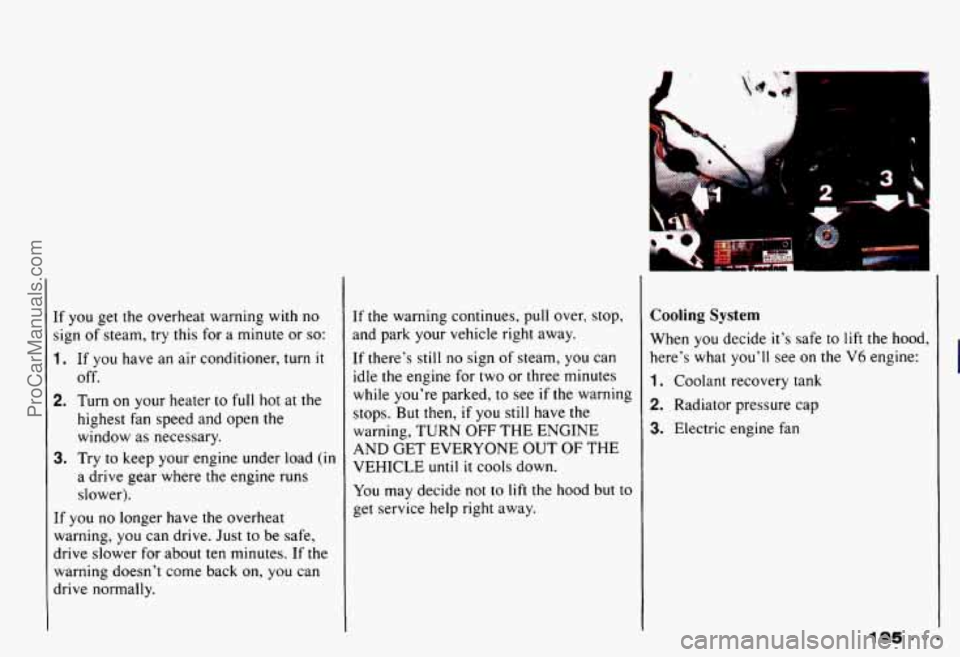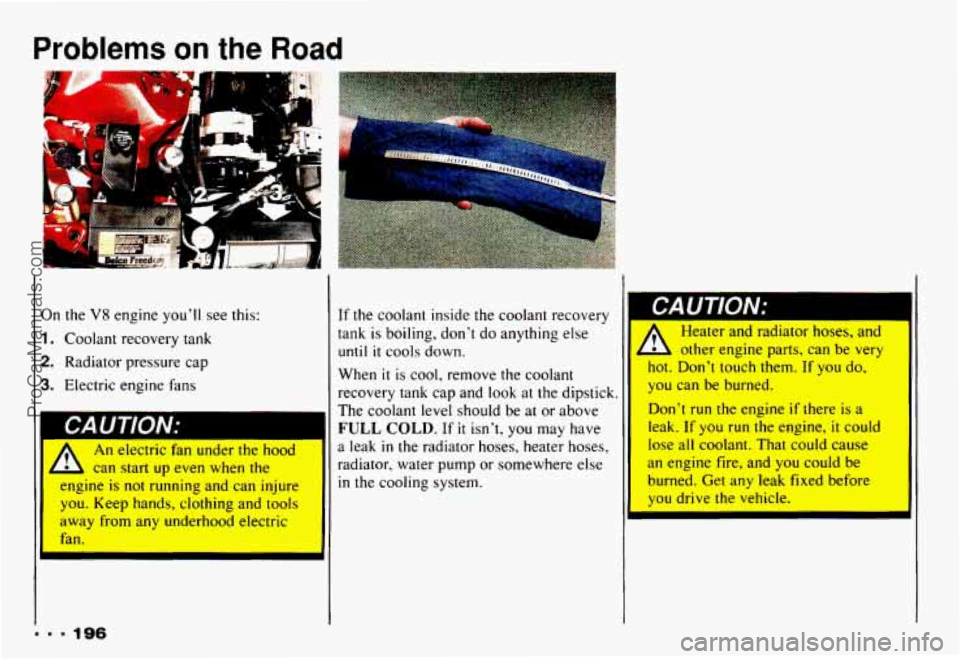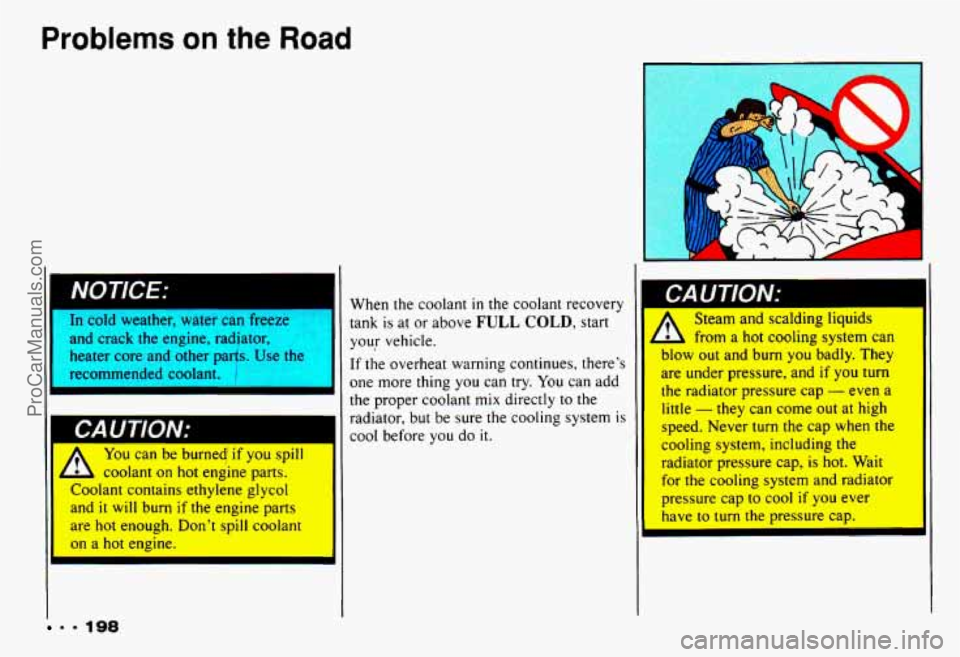Page 199 of 358

If you get the overheat warning with no
sign of steam,
try this for a minute or so:
1. If you have an air conditioner, turn it
2. Turn on your heater to full hot at the
off.
highest fan speed and open
the
window
as necessary.
3. Try to keep your engine under load (in
a drive gear where the engine runs
slower).
If you no longer have the overheat
warning, you can drive. Just
to be safe,
drive slower for about
ten minutes. If the
warning doesn’t come back on,
you can
drive normally. If
the warning
continues, pull over, stop,
and park your vehicle right away.
If there’s
still no sign of steam, you can
idle
the engine for two or three minutes
while you’re parked, to see
if the warning
stops.
But then, if you still have the
warning, TURN
OFF THE ENGINE
AND GET EVERYONE OUT
OF THE
VEHICLE
until it cools down.
You may decide not to
lift the hood but to
get service help right away.
Cooling System
When you decide it’s safe to lift the hood,
here’s what you’ll see on the V6 engine:
1.
2.
3.
Coolant recovery tank
Radiator pressure cap
Electric engine
fan
ProCarManuals.com
Page 200 of 358

Problems on the Road
I. -
.. .
On the V8 engine you’ll see this:
1. Coolant recovery tank
2. Radiator pressure cap
3. Electric engine fans
An electric fan under the hood
L can start up even when the
engine
is not running and can injure
you. Keep hands, clbthing and tools
away from any underhood electric
fan.
... 196
I I
If the coolant inside the coolant recovery
tank
is boiling, don’t do anything else
until it cools down.
When
it is cool, remove the coolant
recovery tank cap and
look at the dipstick. I I
The coolant level should be at or above
FULL COLD. If it isn’t, you may have
a leak
in the radiator hoses, heater hoses,
radiator, water pump or somewhere else
in the cooling system. II
A Heater and radiator hoses, and
L other engine parts, can be very
hot. Don’t touch them.
If you do,
you can be burned. ~
Don’t run the engine if there is a
leak. If
you run the engine, it could
lose
all coolant. That could cause
an engine fire, and you could be
burned. Get any leak fixed before
you drive the vehicle.
ProCarManuals.com
Page 201 of 358

eng~ witho
r
u -.. .
tolar .-
[f there seems to be no leak, check to see
f the electric engine fan is running. If the
:ngine is overheating, the fan should be
-unning.
If it isn’t, your vehicle needs
iervice.
I I
How to Add Coolant to the Coolant
Recovery Tank
If you haven’t found a problem yet, but
the coolant level isn’t
at or above FULL
COLD,
add a 50/50 mixture of clean
water
(preferably distilled) and a proper
antifreeze at the coolant recovery tank.
(See “Engine Coolant”
in the Index for
more information about the proper
coolant
mix.)
A Adding only plain water to
L your cooling system can be
dangerous. Plain water, or some
I
other liquid like alcohol, can boil
before the proper coolant
mix will.
Your vehicle’s coolant warning
system
is set for the proper coolant
mix. With plain water or the wrong
mix, your engine could get too hot
but you wouldn’t get the overheat
warning. Your engine could catch
fire and you or others could
be
burned. Use a 50/50 mix of clean
water
and a proper antifreeze.
197-
ProCarManuals.com
Page 202 of 358

Problems on the Road
and crack the engine, radiator,
heater core and other parts.
Use the
recommended coolant.
‘I
A You can be burne4 if you spill
- L coolant on hot engine parts.
Coolant contains ethylene glycol
and
it will burn if the engine parts
are hot enough. Don’t spill coolant
on
a hot engine.
9.198
When the coolant in the coolant recovery
tank is at or above
FULL COLD, start
your vehicle.
If the overheat warning continues, there’s
one more thing you can
try. You can add
the proper coolant
mix directly to the
radiator, but be sure the cooling system is
cool before you do
it.
I
CAUTION:
Steam and scalding liquids
from a hot cooling system can
blow out and burn you badly. They
are under pressure, and
if you turn
the radiator pressure cap
- even a
little
- they can come out at high
speed. Never
turn the cap when the
cooling system, including the
radiator pressure cap,
is hot. Wait
for the cooling system and radiator
pressure cap to cool
if you ever
have to turn the pressure cap.
ProCarManuals.com
Page 203 of 358
How to Add Coolant to the Radiator
(3.4L L32 (Code S) Engine)
1. You can remove the radiator pressure
cap when the cooling system,
including the radiator pressure cap and
upper radiator hose, is
no longer hot.
Turn the pressure cap slowly
to the
left
until it first stops. (Don't press
down while turning the pressure cap.)
If you hear a hiss, wait for that to stop.
A hiss means there is still some
pressure left.
2. Then keep turning the pressure cap,
but now push down
as you turn it.
Remove the pressure cap.
P
3. Fill the radiator with the proper mix,
up to the base
of the filler neck.
ProCarManuals.com
Page 204 of 358
Problems on the Road
4. Then fill the coolant recovery tank to
FULL COLD.
... 200
.A 1
5. Put the cap back on the coolant
recovery tank, but leave the radiator
pressure cap off.
i
6.
0
Start the engine and let it run until
you can feel the upper radiator hose
getting hot. Watch out for the engine
fan( s).
By this time the coolant level inside
the radiator filler neck
may be lower.
If the level is lower, add more of the
proper
mix through the filler neck
until the level reaches the base of the
filler neck.
ProCarManuals.com
Page 205 of 358
m
7. Then replace the pressure cap. Be sure
the arrows on the pressure cap line up
like this. Hom7 to Add Coolant to the Radiator
(5.7L LTl (Code P) Engine)
.
II
'he 1 engine (Code P) ha
;pecmc radiator fill procedure.
%lure to follow this procedure
1. You can remove the radiator pressure
cap when the
cooling system,
including the radiator pressure cap and
upper radiator hose,
is no longer hot.
Turn the pressure cap
slowly to the
left
until it first stops. (Don't press
down while turning the pressure cap.)
If you hear a hiss, wait for that to stop.
A hiss means there is still some
pressure left.
201 -
ProCarManuals.com
Page 206 of 358
Problems on the Road
-4
I I
2. Then keep turning the pressure cap,
but now push down as you turn it.
Remove the pressure cap.
"sl
You can be burned if you spill
L coolant on hot engine parts.
4. Fill with the proper mix. Add coolant
until you see a steady stream of
coolant coming. from the bleed valves.
,oolant contains ethylene glycol
are
hot enough. Don't spill coolant
on a hot engine.
I
1 and it will burn if the engine parts 11 5. Close the bleed valves.
I
3. After the engine cools, open the air
bleed valves on the heater return hose
and water pump inlet.
. 202
ProCarManuals.com